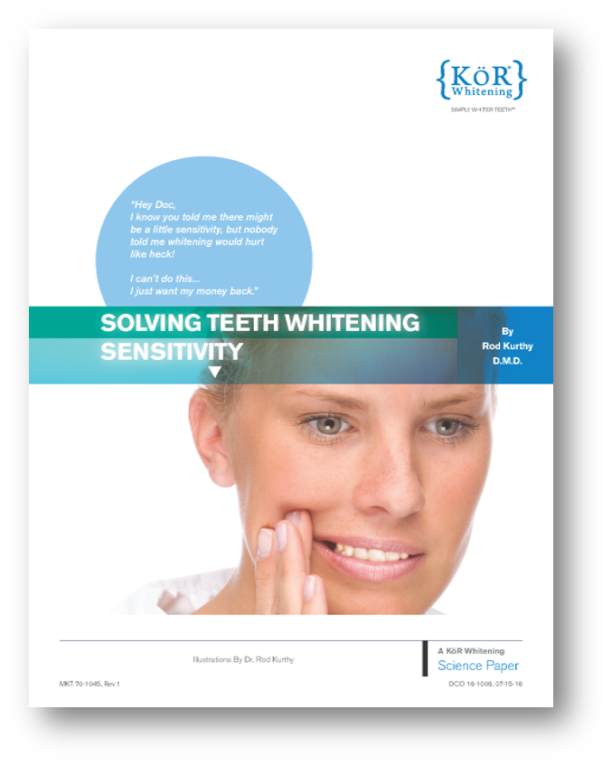When it comes to teeth whitening, sensitivity is one of the more common side effects. Fortunately, KöR Whitening has gone to great lengths to solve this problem. In this article, we will explain the unique approach we take to combat whitening sensitivity.
Current Desensitizing Methods
Generally speaking, there are two categories of desensitizing approaches, which include the following:
1. Occlusion of Dentinal Tubules – The goal is to plug dentinal tubules, preventing movement of intratubular fluid, thereby preventing sensitivity, thus treating the cause of sensitivity.
2. Neuronal Suppression – A chemical effect on pulpal neurons reducing the ability of those neurons to fire, thus treating the symptoms of/masking sensitivity.
Unsuccessful Desensitizing Methods
Many different products and techniques have been tried to reduce whitening sensitivity, but the results have not been consistent. However, it is worth taking a quick look at some of the unsuccessful methods.
1. Modifying Whitening Gels – By altering whitening gels, manufacturers tried to reduce sensitivity. Unfortunately, most dentists found one of two things were true: 1) these gels did reduce sensitivity, but they did not get teeth very white; 2) the claims of reduced sensitivity were false.
2. Flourides – Stannous and sodium fluoride have been used to try and occlude the dentinal tubules, but the process proved too slow and often never fully occlude tubules or cure sensitivity completely. When we need desensitizing with whitening, we need it NOW!
3. ACP – Amorphous Calcium Phosphate helps remineralize enamel, but not the dentin. Use of ACP has not been met with widespread reports of desensitizing success with whitening.
4. Potassium Nitrate – Potassium nitrate does not occlude tubules and it also does not reduce tubular flow. Potassium nitrate has been unpredictable, seemingly effective on some, partially effective on some, and ineffective on some. Though potassium nitrate may reduce sensitivity in some individuals, it simply masks pulpal inflammation and does not eliminate it.
5. Adding Desensitizing Agents to Whitening Gels – Various agents have been mixed into whitening gels to reduce sensitivity. The process of whitening relies on an aggressive oxygenation process and results in the outward flow of dentinal tubular fluid. The passive, orderly process of remineralization and formation of dentinal tubular plugs is incapable of occurring during the aggressive “scrubbing bubbles” oxygenation process of whitening. Desensitizers intended to migrate through the dentinal tubular fluid to the pulp (such as Potassium Nitrate) are incapable of doing so when the tubular fluid is aggressively flowing outward during the whitening process.
The active peroxide whitening process is just not conducive to the intended results of desensitizers of any type. Use of desensitizers is effective only before and/or after whitening, but not when mixed into the whitening gel itself.
“KöR Whitening is leading the way to better teeth whitening with minimal sensitivity.”
KöR’s Solutions to Whitening Sensitivity
KöR Whitening is leading the way to better teeth whitening with minimal sensitivity. Here are some of the methods utilized by KöR Whitening for reduction of whitening sensitivity:
1. Lower Osmolality of the Whitening Gel – Whitening gels with the lowest possible osmolality will reduce the osmotic gradient between the whitening gel and tubular fluid, thereby reducing intratubular flow and sensitivity. KöR gels have as little as 1/11th the osmolality of other whitening gels.
2. Rapid, Aggressive Occlusion of Dentinal Tubules – Rapid, aggressive plugging of dentinal tubules before and after each whitening activity instead of treating symptoms after they occur.
3. Rapid Occlusion of Enamel and Dentin Aberrations – Instantly plugging acquired aberrations (such as cracks and craze lines) in enamel, as well as developmental aberrations (such as enamel lamellae) before and after whitening greatly reduces zinger type sensitivity.
4. Desensitizing Agents – Rather than mixing desensitizers into the whitening gel, it is far more effective to apply before and after whitening treatment.
5. Avoiding Lights or Lasers – Numerous studies have proven the ineffectiveness of lights and lasers while significantly increasing sensitivity.
6. Use of Buffering Agents – Peroxides throw off hydrogen ions during breakdown (Hydrogen ions are acid – “pH” refers to “potential of Hydrogen”), resulting in a lowering of pH (more acid). Use of buffering agents in the whitening gel results in the buffering agents neutralizing acid that is produced, thereby preventing the peroxide gels from rapidly becoming acidic. This prevents smear plugs from being dissolved away by acid during whitening.
7. Refrigeration – KöR Whitening is committed to keeping whitening gels properly refrigerated from the moment they are manufactured until they are delivered cold to the dental office. This leads to more effective whitening and significantly less sensitivity.

To understand more of the science behind teeth whitening sensitivity and the methods used by KöR Whitening to reduce and prevent whitening sensitivity, contact us today.



